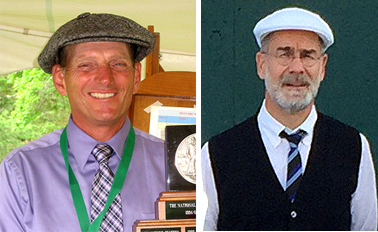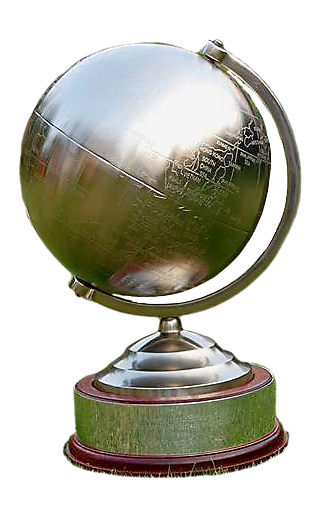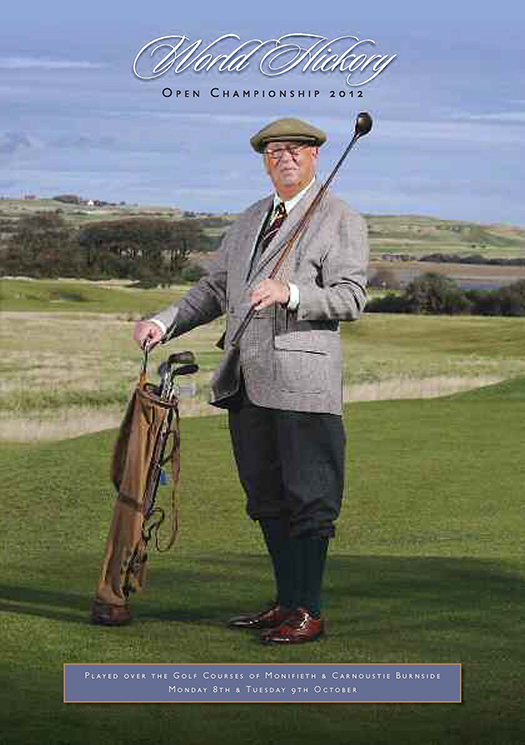Feb. 20, 2018
By Jim Davis

Mike Stevens, left, and Claus Muehlfeit are captains for the 2018 Freedman Cup.
Teams have been announced and a date set, May 1-5, for the 2018 Freedman Cup (formerly the International Hickory Cup). This international fixture of the Society of Hickory Golfers is played in the spirit of international goodwill and hickory golf in honor of the late Lionel Freedman* who did so much to promote both.
Team USA Captain Mike Stevens and Team Europe Captain Claus Muehlfeit have each assembled 16-person teams for the Ryder Cup-Style matches to be played on the Castelconturbia Golf Club in Agrate Conturbia, Italy, May 1-5.
The inaugural USA-European hickory match was held in 2014 on the Monifieth Links of Carnoustie, Scotland in conjunction with the World Hickory Open. WHO founder and organizer Lionel Freedman was instrumental in securing a Rest-of-the-World team for the matches.
Team USA narrowly won that contest by 22½ points to 21½ points.
“This is the first time the International Hickory Cup has been held and the resulting Grand Hickory Match has certainly proved just how competitive and popular hickory golf has become across the globe,” said Freedman, who passed away in January 2017.
The follow-up match was held in February 2016 on the El Campeon course at the Mission Inn Resort at Howey-in-the-Hills, Fla. The U.S. side again prevailed, by 24½ to 17½.

The Freedman Cup, created by Lionel Freedman for the inaugural International Hickory Cup in 2014.
The 2018 matches were the result of much collaboration between U.S. and European hickory players who did not wish to see those inaugural efforts by Mr. Freedman and the SoHG come to an end. Much credit goes to Ben Hollerbach, Mike Stevens, Claus Muehlfeit, and Paolo Quirici for their efforts in producing the necessary ingredients – the venue, the teams, and the desire to honor Mr. Freedman with the title for the international competition.
“I think it is a testament to how respected Lionel was among hickory players the world over,” said U.S. Captain Mike Stevens, of Tampa, Fla. “He was a true gentleman loved by many.”
“To name the event in Lionel’s honor makes much sense for me because without him, without his idea to start the World Hickory Open 12 years ago, we would not have such a strong dedication to hickory golf all over Europe today,” said Claus Muelhfeit of Switzerland, captain of the European team. “And we would not have met many of American hickory players. To name the trophy after him keeps his memory alive and honors his heritage.”
From its side, the U.S.-based Society of Hickory Golfers promotes international hickory golf through its website, its publications, and its interest in the Freedman Cup.
“It’s part of our mission,” says current SoHG President Bill Geisler. “There are many hickory golf organizations throughout the world, from the United Kingdom and Europe, to the U.S. and Australia. We all have in common the same goals and same enjoyment in playing hickory golf. The SoHG wants to support that as much as and whenever and wherever we can.”
Stevens agrees. “From my own experience, these matches will definitely add to the spirit that already exists in hickory golf,” he says. “There are new and lasting friendships forged at all the events held throughout the world.”
Muelhfeit also likes the team spirit and camaraderie that is achieved through hickory golf and hopes this international event, and others like it “will inspire many others that hickory golf is alive and can be played on a highly skilled and competitive level.”
Of course, he added, a little press and media support wouldn’t hurt. But it is the players themselves and organizers of hickory golf tournaments who will keep the sport growing, he said.
“If the players enjoy the Freedman Cup, then we can create a kind of desire within each participant that this match is a great achievement for golf and we can support the tradition of the game and create some momentum for hickory,” he said. “And if we can find passionate organizers for future events, with help from dedicated sponsors to manage the cost and time, I will expect that it will continue for the next 100 years.”
Given the current level of dedication, there seems no reason why the Freedman Cup cannot continue, so that Muehlfeit’s great-grand children can hear tales of their ancestor’s exploits in the 2018 version.
On paper, the 2018 contest may give a slight nod to the European side whose number includes Constantino Rocca, one of Italy’s most successful professional golfers. He has five European tour wins and is most remembered for his battle with John Daly for the 1995 Open Championship, in which he earned a second place. He has played in the Masters Tournament and was the first Italian to play for Europe in the Ryder Cup. His appearances in 1993, 1995 and 1997 earned him a 6-5-0 win-loss-half record.
Also on the European team are: Baldovino Dassu, an European touring pro with two wins, and six other golf professionals that include Andrew Marshall and Paolo Quirici, both former champions of the World Hickory Open. The team is completed with eight other top hickory players from the U.K., Italy, Germany, and Switzerland.
On its side, the U.S. counts Stevens and fellow golf professionals Tom McCrary (Florida) and Bo Turocy (South Carolina). Others in the field include Ben Hollerbach (who had a second-place finish in the 2012 U.S. Hickory Open), and seasoned international hickory veterans Deal Hudson, Bill Geisler, Hugh Cameron (Canada), Jim Wilhelm, Sean Kelly, and David Brown. Several other single-digit handicap men round out the team.
Click here to see the team rosters.
On paper, the Europeans, led by Rocca, seem a formidable bunch. So, how does U.S. Captain Stevens, himself a U.S. teaching professional with multiple hickory titles under his belt, view the U.S. side’s chances?
“It would certainly appear that the Europeans should be favored based on their lineup but hickories have a way of evening things out sometimes,” he said. “I think we’ll give them a run for their money.”
Switzerland’s Muelhfeit believes the sides are more or less evenly matched. “Each team wants to win, of course,” he said. “We choose carefully the players to represent many European countries. I do think that our chances are better than in 2016 in Florida when we did not perform well.
“I would not mind to have a little number of points more on the European count on Saturday afternoon,” he added.
As in the Ryder Cup itself, much depends on such variables as the captains’ team selections for the foursomes and the competitors chosen for each singles match.
Beyond the competition, Stevens noted how exciting it is to see some very top golfers in the field. “It is nice to see some notable golfers still honoring the history of our game,” he said. “At this point there are more on the European side with such players as Sandy Lyle and Ian Woosnam getting into hickory and others who have played on their tours like Paolo Quirici and Andrew Marshall. I hear that Tommy Fleetwood just received a new set of Tad Moore originals. It would be nice to see more American pros getting involved. Then, maybe events like this will get a bit more notice.”
(Fleetwood is a British pro who is a four-time winner on the European tour. Moore is a U.S. club designer and maker of authentic replica hickory clubs. He has also built clubs for Sandy Lyle.)
It promises to be a stylish affair, too. Many hickory tournaments are played with preference toward plus-fours and shirt-and-tie for the gentlemen, a fashion nod toward the golden era of hickories in the 1920s. For the Freedman Cup, players for both teams will be outfitted in matching ties and sports jackets. They will look as fine as any Ryder Cup team and in traditional, historical styles.
The venue is the Robert Trent Jones-designed Castleconturbia Golf Club, which opened in 1984. An hour north of Milan, the course has three nine-hole loops, two of which, the Yellow (Pines) and Blue (Chestnut), were combined to host the Italian Open. José Maria Olazabal won the Italian Open here in 1998.
Of the course, Jones said, “Apart from the remodeling of “I Roveri,” it had been over 10 years since I had done a new course in Italy. I was excited to be back, and the land was wonderful, beautiful trees, ample surface area and ideal topography for a golf course. I had no doubt that we could accomplish something special. It seems that history has borne me out. Two national Opens are an honor to any golf course.”
Reviewers have noted the necessity for accurate approach shots to large, but hard-to-read greens. In the distance are lovely views of the mountains in the Apeninne Range. Organizers will arrange the course to play at 5,785 yards for the Freedman Cup.

Lionel Freedman posed for the 2012 World Hickory Open poster.
* Lionel Freedman was a top amateur in the U.K. for many years, holding his own with well known British professionals and other amateurs. He played out of golf clubs in London, Surrey, and Berkshire-Wimbledon Park, Roehampton, Henley, Coombe Hill, St Georges Hill, and Wentworth where he resided with his wife on the 15th hole of the West course.
Freedman was Captain of both The Musselburgh and Musselburgh Old Course. He was Musselburgh Old Course Secretary and Treasurer in 1999-2005 and is considered to be “the man who revived the Old Links.”
He was a member of the British Golf Collectors Society and served as an international liaison with the SoHG. He helped coordinate such international matches as an American hickory golf team that plays in a triangular match with a World Team and the BGCS, as well as the International Hickory Cup (now the Freedman Cup) of the SoHG.
Freedman founded the World Hickory Open in 2005 and was a member of Craigielaw Golf Club in Aberlady, East Lothian. He was Captain of the club in 2007-09. In 2014, he served as the honorary starter for the inaugural World Hickory Match Play, held at the Philadelphia Cricket Club in 2014.
He passed away on Jan. 9, 2017.
